
A boat is a watercraft of a large range of types and sizes, but generally smaller than a ship, which is distinguished by its larger size, shape, cargo or passenger capacity, or its ability to carry boats.

A ship is a large watercraft that travels the world's oceans and other sufficiently deep waterways, carrying goods or passengers, or in support of specialized missions, such as defense, research, and fishing. Ships are generally distinguished from boats, based on size, shape, load capacity, and purpose. In the Age of Sail a "ship" was a sailing vessel defined by its sail plan of at least three square rigged masts and a full bowsprit.
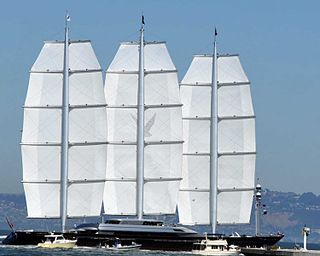
A yacht is a sailing or power vessel used for pleasure, cruising, or racing. There is no standard definition, so the term applies to such vessels that have a cabin with amenities that accommodate overnight use. To be termed a yacht, as opposed to a boat, such a pleasure vessel is likely to be at least 33 feet (10 m) in length and may have been judged to have good aesthetic qualities.
A man overboard rescue turn is a shiphandling manoeuvre usually implemented immediately upon learning of a person having gone overboad into the sea. To bring a vessel closer to the person's location, implementations of the principles described are: the Anderson turn, the quick turn, the Williamson turn, and the Scharnow turn.

Watercraft, also known as water vessels or waterborne vessels, are vehicles used in and on water, including boats, ships, hovercraft, and submarines. Watercraft usually have a propulsive capability and hence are distinct from a simple device that merely floats, such as a log raft.
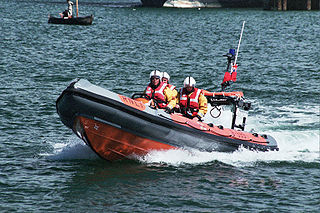
A rigid inflatable boat (RIB), also rigid-hull inflatable boat or rigid-hulled inflatable boat (RHIB), is a lightweight but high-performance and high-capacity unsinkable boat constructed with a rigid hull bottom joined to side-forming air tubes that are inflated with air to a high pressure so as to give the sides resilient rigidity along the boat's topsides. The design is stable, light, fast and seaworthy. The inflated collar acts as a life jacket, ensuring that the vessel retains its buoyancy, even if the boat is taking on water. The RIB is an evolutionary development of the inflatable boat with a rubberized fabric bottom that is stiffened with flat boards within the collar to form the deck or floor of the boat.

An inflatable boat is a lightweight boat constructed with its sides and bow made of flexible tubes containing pressurised gas. For smaller boats, the floor and hull is often flexible, while for boats longer than 3 metres (9.8 ft), the floor typically consists of three to five rigid plywood or aluminium sheets fixed between the tubes, but not joined rigidly together. Often the transom is rigid, providing a location and structure for mounting an outboard motor.
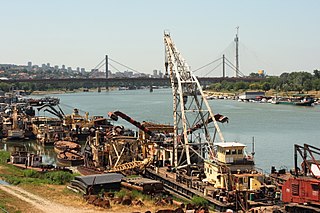
A riverboat is a watercraft designed for inland navigation on lakes, rivers, and artificial waterways. They are generally equipped and outfitted as work boats in one of the carrying trades, for freight or people transport, including luxury units constructed for entertainment enterprises, such as lake or harbour tour boats. As larger water craft, virtually all riverboats are especially designed and constructed, or alternatively, constructed with special-purpose features that optimize them as riverine or lake service craft, for instance, dredgers, survey boats, fisheries management craft, fireboats and law enforcement patrol craft.
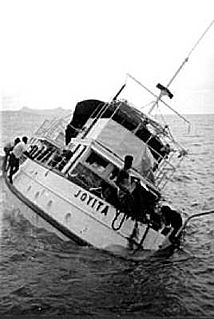
MV Joyita was a merchant vessel from which 25 passengers and crew mysteriously disappeared in the South Pacific in October 1955. She was found adrift with no one aboard.

"Man overboard!" is an exclamation given aboard a vessel to indicate that a member of the crew or a passenger has fallen off of the ship into the water and is in need of immediate rescue. Whoever sees the person's fall is to shout, "Man overboard!" and the call is then to be reported once by every crewman within earshot, even if they have not seen the victim fall, until everyone on deck has heard and given the same call. This ensures that all other crewmen have been alerted to the situation and notifies the officers of the need to act immediately to save the victim. Pointing continuously at the victim may aid the helmsman in approaching the victim.
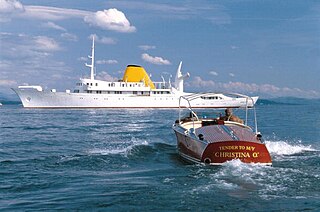
A yacht tender is a vessel used for servicing and providing support and entertainment to a private or charter yacht. They include utilitarian craft, powered by oar or outboard motor, and high-speed luxury craft, supporting superyachts, powered by inboard engines, some using water-jets. Some superyachts have a support vessel that follows them with bulky items that are not conveniently stowed aboard the main yacht, such as a helicopter, automobile or larger watercraft.

A lifeboat or liferaft is a small, rigid or inflatable boat carried for emergency evacuation in the event of a disaster aboard a ship. Lifeboat drills are required by law on larger commercial ships. Rafts (liferafts) are also used. In the military, a lifeboat may double as a whaleboat, dinghy, or gig. The ship's tenders of cruise ships often double as lifeboats. Recreational sailors usually carry inflatable liferafts, though a few prefer small proactive lifeboats that are harder to sink and can be sailed to safety.

The steamboat Mizpah operated in the early 1900s as part of the Puget Sound Mosquito Fleet.
A rescue lifeboat is a boat rescue craft which is used to attend a vessel in distress, or its survivors, to rescue crew and passengers. It can be hand pulled, sail powered or powered by an engine. Lifeboats may be rigid, inflatable or rigid-inflatable combination-hulled vessels.
The BRP Simeon Castro (PC-374) is the fourth ship of the Jose Andrada class coastal patrol boats of the Philippine Navy. It is part of the first batch of its class ordered through US Foreign Military Sales (FMS) in 1989, and was commissioned with the Philippine Navy on 24 June 1991. It was initially designated as Fast Patrol Craft, and was numbered "DF-374", but later on was re-designated as a Patrol Gunboat, and was re-numbered as "PG-374", until another round of reclassification changed its designation as a Patrol Craft with hull number "PC-374" from April 2016.
The BRP Nestor Reinoso (PC-380) is the tenth ship of the Jose Andrada class coastal patrol boats of the Philippine Navy. It is part of the second batch of its class ordered through US Foreign Military Sales (FMS) in 1993, and was commissioned with the Philippine Navy on 1 June 1995.
BRP Federico Martir (PC-385) is fourteenth ship of the Jose Andrada-class patrol craft coastal patrol craft of the Philippine Navy. It is part of the second batch of its class ordered through US Foreign Military Sales (FMS) in 1993, and was commissioned with the Philippine Navy on 22 May 1996. She is currently in active service with the Littoral Combat Force, Philippine Fleet.
The Hybrid Trimaran is a gas and wave-powered trimaran vessel under construction.

Splinter fleet or Splinter navy was a nickname given to the wooden boats used in World War II. The boats served in many different roles during the war. These boats were built in small boatyards on the West coast and East coast, Great Lakes and the Gulf of Mexico. They could be built quickly, in just 60 to 120 days. Most of the boats were built by boatyards that already had the tools and knowledge from building yachts, sailboats and motor boats. Many were built by craftsmen in family-owned small businesses. Under the Emergency Shipbuilding Program and War Shipping Administration contracts went out to over fifty boatyards across the country. The boats were built for the US Navy, the, United States Army Air Forces, United States Coast Guard, and US Army. Some of the wooden boats went to Allied nations on the Lend-Lease program.














